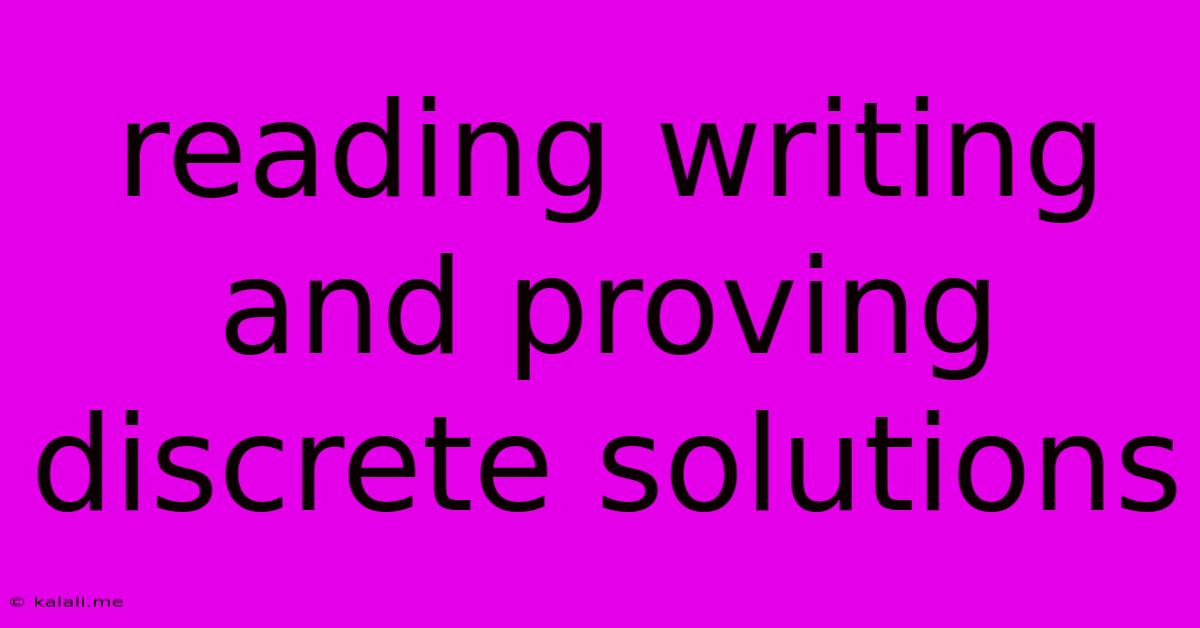Reading Writing And Proving Discrete Solutions
Kalali
May 30, 2025 · 3 min read

Table of Contents
Reading, Writing, and Proving Discrete Solutions: A Comprehensive Guide
Meta Description: Master the art of solving discrete problems! This guide explores the crucial skills of reading, writing, and proving solutions, equipping you with the tools to tackle complex mathematical challenges with confidence. Learn to translate problems, construct rigorous proofs, and communicate your findings effectively.
Discrete mathematics forms the bedrock of computer science, cryptography, and numerous other fields. Its problems often involve logic, sets, graphs, and algorithms. Successfully navigating this landscape requires more than just finding a solution; it demands the ability to read the problem clearly, write a concise and accurate solution, and prove its correctness rigorously. This article delves into these three crucial skills.
I. Reading the Problem: Deconstructing the Challenge
The first step, often overlooked, is meticulous problem reading. Many students jump straight into calculations, only to find they've misinterpreted the question. Effective reading involves:
-
Identifying Key Terms: Understand the specific definitions of terms used. In discrete math, a single word can significantly alter the problem's meaning. For example, the difference between "subset" and "proper subset" is critical.
-
Visualizing the Problem: Whenever possible, draw diagrams, graphs, or tables to represent the problem visually. This can clarify relationships and reveal patterns you might miss otherwise. This is especially helpful in graph theory problems or those involving sets and relations.
-
Breaking Down Complex Problems: Large problems often consist of smaller, interconnected subproblems. Break the problem into manageable parts to make it less daunting and easier to analyze. This might involve identifying intermediate goals or using a divide-and-conquer strategy.
-
Stating the Goal Explicitly: Before starting any calculations, write down precisely what you need to find or prove. This helps keep you focused and prevents you from getting lost in irrelevant details.
II. Writing the Solution: Communicating Your Reasoning
Once you have a solution, articulating it clearly is paramount. A well-written solution demonstrates not just the answer, but also the reasoning behind it. This involves:
-
Clear and Concise Language: Avoid ambiguity. Use precise mathematical notation and terminology. Define any variables or symbols you introduce.
-
Logical Structure: Present your solution step-by-step, following a logical sequence. Each step should follow directly from the previous one.
-
Justification of Each Step: Don't just state the answer; explain why each step is valid. This involves citing relevant theorems, definitions, or logical rules. For example, if you use induction, clearly state the base case, inductive hypothesis, and inductive step.
-
Using Appropriate Notation: Employ standard mathematical notation correctly. This enhances readability and ensures clarity. Inconsistencies in notation can confuse the reader and obscure the logic of your argument.
-
Illustrative Examples: If appropriate, include examples to illustrate your solution method or to clarify abstract concepts.
III. Proving the Solution: Establishing Correctness
The hallmark of a strong discrete mathematics solution is a rigorous proof. This establishes the correctness of your solution beyond doubt. Common proof techniques include:
-
Direct Proof: A straightforward demonstration of the statement's truth, typically using definitions and previously proven theorems.
-
Proof by Contradiction: Assuming the negation of the statement and deriving a contradiction, thus proving the original statement.
-
Proof by Induction: Demonstrating the truth of a statement for a base case and then showing that if it's true for a given case, it must also be true for the next case.
-
Proof by Contrapositive: Proving the contrapositive of the statement, which is logically equivalent to the original statement.
-
Proof by Cases: Dividing the problem into distinct cases and proving the statement for each case separately.
The choice of proof technique depends on the nature of the problem. The key is to choose a method appropriate for the problem and to present the argument clearly and logically.
Conclusion: Mastering the Trifecta
Reading, writing, and proving discrete solutions are interconnected skills. Mastering each one is crucial for success in discrete mathematics and related fields. By focusing on careful reading, clear writing, and rigorous proof techniques, you will not only solve problems effectively but also communicate your solutions with precision and confidence. This approach will equip you to tackle more complex problems and contribute meaningfully to the field.
Latest Posts
Latest Posts
-
Best Way To Sell Engagement Ring
May 31, 2025
-
Can You Get A Condor Lufthansa Ticket
May 31, 2025
-
Can I Tell Someone My Tip Is A Gift
May 31, 2025
-
Dragons Of Lord Of The Rings
May 31, 2025
-
How Do I Stop My Auxiliary Heat From Coming On
May 31, 2025
Related Post
Thank you for visiting our website which covers about Reading Writing And Proving Discrete Solutions . We hope the information provided has been useful to you. Feel free to contact us if you have any questions or need further assistance. See you next time and don't miss to bookmark.